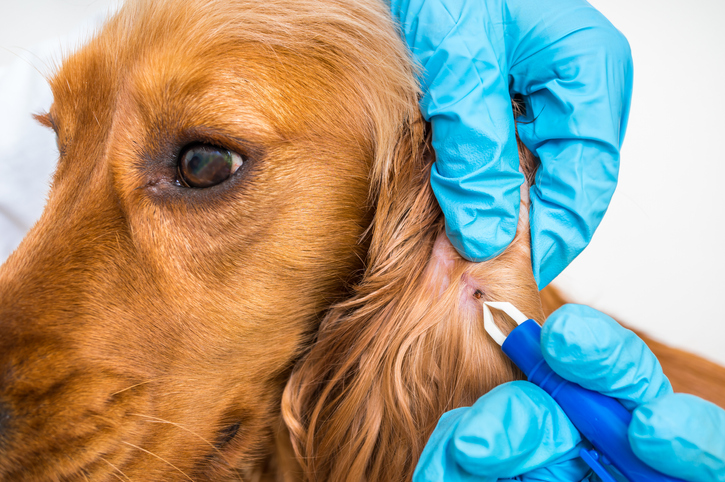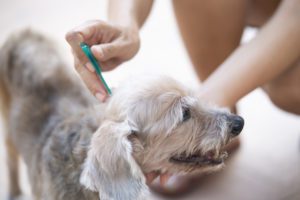How to Remove a Tick from a Dog in Rye, NH
Does your dog have a tick? Do you know how to remove ticks safely from a dog without risking infection? What should you do if you spot a tick latched onto your pet’s skin? These questions are common among pet owners who spend time in nature with their dogs, and if you’re wondering the same, you’re not alone.
In this article, we’ll walk you through the basics you need to know about removing a tick from your dog. With the help of this information, you can prepare your dog for the process, remove the tick, and clean up afterward with no trouble.
Gather Your Materials
First, gather the materials you’ll need and keep them close to you during the whole procedure. You will need a pair of sharp tweezers, a washcloth soaked in warm water with a little bit of soap, some antibiotic ointment, treats for your dog, and good lighting to work by.
You may also need a second person to help you and a pair of scissors if your dog’s hair is too long to see the tick well. Keep all your materials within arm’s reach as you work.
Locate the Tick
The next step is to locate the tick on your dog’s body. Keep in mind that your dog may be very nervous during this step, especially if the tick has been biting for a while already. You might need to ask for assistance from another family member for this part of the process.
Part your dog’s hair at the site of the bite until you can clearly see the tick. If your dog has very long hair, it may be necessary to gently trim some of it, taking care not to cut the tick with the scissors.

Grasp the Tick with the Tweezers
Next, grasp the tick with the tweezers. Do not grip the tick by the body, as doing so will cause the body to break away from the mouthparts and leave the “head” inside the skin. Instead, try to grip the tick behind its head, so that the tweezers can access both the head and body at the same time.
The tick may be buried completely under the skin. If so, you will need to grasp it as close to the skin’s surface as possible. This may be painful to your dog, so be prepared to prevent an escape during the process.
Pull to Remove
Once you’re sure you’ve got a good grasp of the tick and have positioned the tweezers so that they won’t break off the mouthparts, it’s time to remove the tick. Pull straight up with the tweezers, taking care not to pull at an angle from your dog’s skin. Do not twist or pull too quickly, and do not angle your tweezers at all.
If you pull firmly but slowly, you will release the tick’s whole body and mouthparts all as one. If you do this part incorrectly, you may leave the mouthparts behind in the skin, and you’ll need to remove them separately.
Check the Skin
With the tick fully removed, it’s time to check the location of the bite for any concerning signs. Double-check that the mouthparts are removed from the skin and look for any signs of beginning infection. If the skin looks very red and inflamed (more than is normal with a tick bite) or the area is swollen at all, your dog may need to see a vet.
Carefully examine the wound left behind by the tick bite as well. Make sure you know what it looks like now, so you can monitor it for any changes in the coming days.

Wash and Medicate
Finally, it’s time to wash and medicate your dog’s skin. Use the washcloth with warm water and soap to gently clean the bite area, and then rub a thin layer of antibiotic ointment into the skin. Keep your dog distracted for a few minutes until the ointment can dry, so she does not lick it off immediately.
Once you’ve finished with the whole process, make sure you give your pet plenty of treats and praise for being so good! Tick removal can be painful and scary for dogs, so let her know she’s done a great job.
Conclusion
When dogs get ticks, it is normal for pet owners to be a little bit concerned. However, if you are careful about removing the tick and caring for the wound until it heals, you can help your dog reduce her risk of infection significantly.
There is always the potential for tickborne illness following any tick bite. If it is possible to do so, keep the tick in a plastic baggie and take it to the vet to be checked out. The vet can tell you from there if the tick is a type that can be harmful to dogs.
Please give us a call at (603) 431-8785 or Make An Appointment for any questions regarding your dogs health.
Recent Posts
About Us
We're proud to have many long-time staff members at our hospital who get along like family and treat their patients and clients the same. The compassion and commitment of our veterinarians and staff make our team a reliable, trusted partner for you and your pet.

